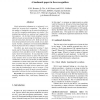Free Online Productivity Tools
i2Speak
i2Symbol
i2OCR
iTex2Img
iWeb2Print
iWeb2Shot
i2Type
iPdf2Split
iPdf2Merge
i2Bopomofo
i2Arabic
i2Style
i2Image
i2PDF
iLatex2Rtf
Sci2ools
FGR
2006
IEEE
2006
IEEE
A Landmark Paper in Face Recognition
Good registration (alignment to a reference) is essential for accurate face recognition. The effects of the number of landmarks on the mean localization error and the recognition performance are studied. Two landmarking methods are explored and compared for that purpose: (1) the Most Likely-Landmark Locator (MLLL), based on maximizing the likelihood ratio [2], and (2) Viola-Jones detection [14]. Both use the locations of facial features (eyes, nose, mouth, etc) as landmarks. Further, a landmark-correction method (BILBO) based on projection into a subspace is introduced. The MLLL has been trained for locating 17 landmarks and the Viola-Jones method for 5. The mean localization errors and effects on the verification performance have been measured. It was found that on the eyes, the Viola-Jones detector is about 1% of the interocular distance more accurate than the MLLL-BILBO combination. On the nose and mouth, the MLLL-BILBO combination is about 0.5% of the inter-ocular distance more a...
| Added | 11 Jun 2010 |
| Updated | 11 Jun 2010 |
| Type | Conference |
| Year | 2006 |
| Where | FGR |
| Authors | G. M. Beumer, Qian Tao, Asker M. Bazen, Raymond N. J. Veldhuis |
Comments (0)

